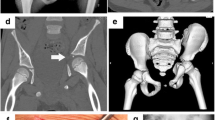Abstract
Purpose
To determine the most common injury patterns, root cause, and the frequency with which unrecognized contralateral posterior ring injury occurs in patients presenting with surgically treated pelvic fractures.
Methods
The medical records of 73 patients presenting to our level I trauma center (52 male and 21 female patients; mean age 41.8 years; range 18–89 years) with surgically treated pelvic ring fractures between January 1, 2016 and January 1, 2018 were reviewed. Patient demographics, mechanism of injury, associated injuries, imaging prior to binder or external fixation, use of temporary stabilization with pre-peritoneal pelvic packing (PPP) and anterior pelvic external fixation, and fracture pattern were recorded and analyzed to identify independent risk factors contributing to occult contralateral missed posterior ring injury.
Results
Occult contralateral pelvic ring injuries occurred in 6/72 patients (8.2% incidence). Pelvis fractures in multiply traumatized patients with associated orthopaedic injuries were associated with higher prevalence of occult contralateral pelvic ring injury (relative risk 1.85, 95% CI 1.13–3.02) as compared to patients with isolated pelvic fractures.
Conclusions
There is an 8.2% incidence of unrecognized contralateral SI joint instability in patients presenting with unstable pelvic ring injuries. Multiply traumatized patients with multiple orthopaedic injuries were an independent risk factor for this injury pattern.


Similar content being viewed by others
References
Pennal GF, Tile M, Waddell JP, Garside HJ (1980) Pelvic disruption: assessment and classification. Clin Orthop Relat Res 151:12–21
Burgess AR, Eastridge BJ, Young JW et al (1990) Pelvic ring disruptions: effective classification system and treatment protocols. J Trauma 30:848–856
Burlew CC (2017) Preperitoneal pelvic packing for exsanguinating pelvic fractures. Int Orthop 41(9):1825–1829
Blum L, Hake ME, Charles R, Conlan T, Rojas D, Martin MT, Mauffrey C (2018) Vertical shear pelvic injury: evaluation, management, and fixation strategies. Int Orthop 42(11):2663–2674
Swartz J, Vaidya R, Hudson I, Oliphant B, Tonnos F (2016) Effect of pelvic binder placement on OTA classification of pelvic ring injuries using computed tomography. Does it mask the injury? J Orthop Trauma 30(6):325–330
Fletcher J, Yerimah G, Datta G (2016) The false security of pelvic binders: 2 cases of missed injuries due to anatomical reduction. J Orthop Case Rep 6(1):44–47
Suzuki T, Morgan SJ, Smith WR et al (2010) Stress radiograph to detect true extent of symphyseal disruption in presumed anteroposterior compression type I pelvic injuries. J Trauma 69:880–885
Sagi HC, Coniglione FM, Stanford JH (2011) Examination under anesthetic for occult pelvic ring instability. J Orthop Trauma 25:529–536
Brooks A, Holroyd B, Riley B (2004) Missed injury in major trauma patients. Injury 35(4):407–410
Buduhan G, McRitchie DI (2000) Missed injuries in patients with multiple trauma. J Trauma 49(4):600–605
Gruen RL, Jurkovich GJ, McIntyre LK, Foy HM, Maier RV (2006) Patterns of errors contributing to trauma mortality: lessons learned from 2,594 deaths. Ann Surg 244(3):371–380
Houshian S, Larsen MS, Holm C (2002) Missed injuries in a level I trauma center. J Trauma 52(4):715–719
Starks I, Frost A, Wall P, Lim J (2011) Is a fracture of the transverse process of L5 a predictor of pelvic fracture instability? Bone Jt J 93(B):967–969
Burlew C, Moore E, Mauffrey C et al (2017) Preperitoneal pelvic packing reduces mortality in patients with life-threatening hemorrhage due to unstable pelvic fractures. J Trauma Acute Care Surg 82(2):233–242
Osborn PM, Smith WR, Moore EE et al (2009) Direct retroperitoneal pelvic packing versus pelvic angiography: a comparison of two management protocols for haemodynamically unstable pelvic fractures. Injury Int J Care Injured 40(1):54–60
Mauffrey C, Cuellar DO III, Pieracci F, Hak DJ, Hammerberg EM, Stahel PF, Burlew CC, Moore EE (2014) Strategies for the management of haemorrhage following pelvic fractures and associated trauma-induced coagulopathy. Bone Joint J 96-B:1143–1154
Mauffrey C, Mavrogenis AF (2017) Quality, cost and outcomes measures in orthopaedic healthcare. Int Orthop 41(9):1705–1708
Acknowledgments
The authors acknowledge Dr. Angela Sauaia, MD, PhD, for performing the statistical analyses.
Author information
Authors and Affiliations
Corresponding author
Ethics declarations
Conflict of interest
The authors declare that they have no conflict of interest.
Rights and permissions
About this article
Cite this article
Maertens, A.S., Martin, M.P., Dean, C.S. et al. Occult injuries of the contralateral sacroiliac joint in operatively treated pelvis fractures: incidence, root cause analysis, and proposal of treatment algorithm. International Orthopaedics (SICOT) 43, 2399–2404 (2019). https://doi.org/10.1007/s00264-018-4268-1
Received:
Accepted:
Published:
Issue Date:
DOI: https://doi.org/10.1007/s00264-018-4268-1




